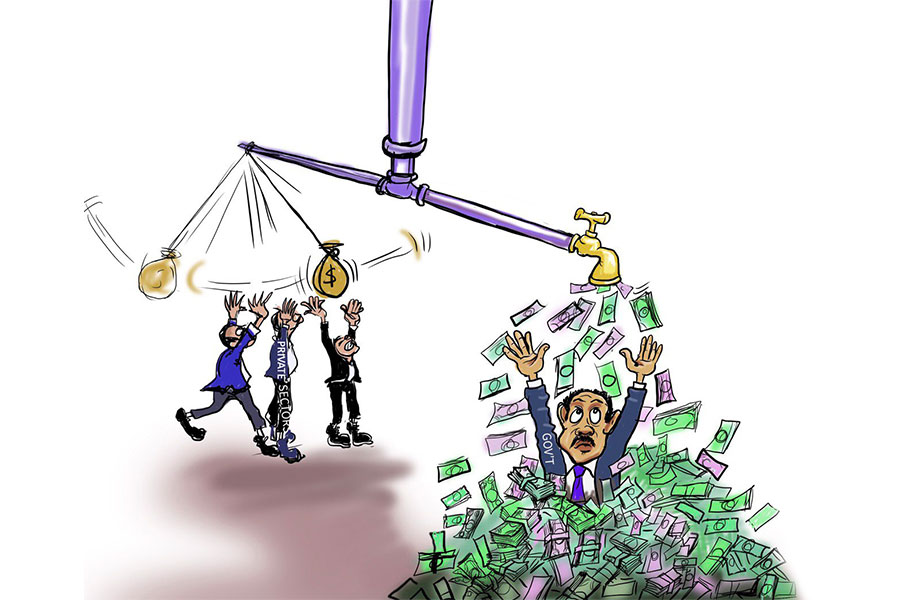
Editorial | May 21,2022
Mar 7 , 2020
By Getachew Asfaw
Many economists believe that the economic problem of the country is structural rather than cyclical. But these two are not mutually exclusive, writes Getachew Asfaw (getachewasfaw240@gmail.com), who holds an MSc in national economic planning.
The state can plan as much as it wants, but it should plan, not by directions, but by manipulating the market, as Arthur Lewis, one of the most recognised development economists of the last century, said.
Looking at it from an ideological angle, socialist countries pursue directive planning and capitalist countries adopt indicative planning.
How does the current, presumably capitalist-oriented, Ethiopian planning system and its procedures observe the above remark by the well-known economist?
How does the Homegrown Economic Reform Agenda relate to manipulating the market rather than repeating, with different words, the socialist-oriented EPRDF policies of the last few decades? Has the programme stated in black and white its ability to counter the evils of the cyclical ups and downs of the market?
Many economists believe that the economic problem of the country is structural rather than cyclical. But these two are not mutually exclusive.
It is thus crucial to distinguish between professional planning, solely performed by experts, and participatory planning, which takes into account what the majority says. No doubt macroeconomics falls under the domain of professional planning and sectoral development, while project planning can involve a mix of professional and participatory planning.
We need to be clear that planning is an instrument of how to apply policies on the ground. By way of introducing its policies to the people, the government always talks about balancing the macroeconomy.
What are the elements of macroeconomy? What is to be balanced and in what way? Is it a short-term or long-term phenomenon?
I doubt any document by the government makes this clear. Although the Central Statistics Agency (CSA) provides raw data, there is no responsible government body to analyse at a microeconomics level why individual prices fluctuate.
Under these circumstance, where the government does not know how prices are determined, how can it manipulate the market? At the macro level, do the government officials have a clear picture of why inflation occurs or why the number of disguised and open unemployment levels stand at half of the labour force? Do they worry about the trade-off between the policy of reducing the inflation rate and the policy of reducing unemployment? How can they make choices between alternative methods?
Can they come up with a proper combination of monetary and fiscal policies of balancing inflation and unemployment targets? After all, do they set final, intermediate and immediate targets and performance indicators as well as policy instruments and act accordingly?
Fiscal and monetary macroeconomic policies as decisive guiding principles of macroeconomic planning can be distinguished as expansionary or contractionary, depending upon which macroeconomic variable they wish to bring under control. Reducing inflation needs contractionary fiscal and monetary policies, whereas reducing unemployment needs expansionary fiscal and monetary policies.
The manifestations of fiscal policy might require a smaller or larger government, big or small tax revenues, greater or lesser government expenditures or varying levels of deficit financing. Here we can ask what the various public finance theories tell us about the advantages and disadvantages of smaller and larger governments and what gives the right to the government to collect the amount of taxes it manages.
Can we broadly categorise the duties of the government to assign to it the tax rate it rightfully can claim? Does the tax system allocate to the private sector sufficient resources to play its traditional role of being the driving force of the economy, or does it crowd out the fair play rules of the private sector? How do developmental and liberal governments respond differently to these issues? In what sense is state failure better than market failure or the other way round?
When it comes to monetary policy, do economists and public officials talk the same language? Do they distinguish between different types of monetary components such as currency and bank deposits by the level of liquidity? Does the monetary policy trickle down to the exchange rate policy?
It surprises me when highly trained economists, government officials and even bankers do not distinguish between finance, money and currency when speaking in the official language. Genzebis interpreted as currency, money and finance.
Which type of Genzebis in short supply in the market and why?
Currency is predominantly needed by households and small businesses, credit money is needed by big businesses, and securities are needed by both individual and institutional investors.
As a result of this lack of understanding of the micro and macroeconomic fundamentals, we have ended up in a mismatch between real economy accumulation and financial assets accumulation. This could cost society a great deal to rectify, and balanced policies are needed to reduce inflation and unemployment. The national bank issues currency, credit money is issued by commercial banks, and securities are issued by financial and non-financial establishments. There must be an organisation that coordinates the supply and demand by manipulating the financial market.
As the country follows the credit-based financial system, overhauling the credit statistics is sufficient to give a clue as to the adequacy of monetary assets in the economy.
As of the 2018/19 fiscal year, the excess reserves of the commercial banks deposited at the central bank is large, almost equal to the required reserves at more than 40 billion Birr, and there is no significant bank-to-bank or inter-bank lending, according to the National Bank of Ethiopia (NBE).
Except for a negative annual percentage change in 2018/19, throughout the years 2015/16 to 2018/19, financial deepening (or rather monetary deepening) measured by the ratio of broad money to GDP has been increasing from 0.28 to 0.34. These and other findings show us that the economy is liquid.
There has not been a significant shift in the trends of the year-to-year money multiplier measured by the various proportions of reserve money or narrow money to broad money or vice versa. However, the long-term proportion of currency has fallen drastically, yielding to increased proportions of bank deposits. In the face of such practical data, I wonder where people get the information that the economy is illiquid or that lack of finance is the major constraint to private sector development.
It has indeed been strange to witness a high inflation rate and shortage of monetary finance at the same time.
If the economy is truly facing a liquidity problem and the national bank attempts to lend to the commercial banks, the money supply in the economy will increase. As a result, inflation will exasperate, and this will lend itself to decreased saving, harming future deposits. Ever-increasing indebtedness of the real economy to the banking sector will create a financial crisis just as it has in other countries.
Finance is composed of currency, money, and various types of debt and equity securities.
What is the proportion of each of these components of financial assets in the Ethiopian financial system? Could there be a correct mix of each of these components? Why do people talk about the shortage of finance when they do not know which type of finance is in short supply?
How can we move from the currently practised credit-based financial system to the market-based financial system when we do not identify the different types of financial assets by their liquidity levels? How are we going to determine market values and interest rates for each type of financial asset? Who has ever spoken of the meaning of the various interest rates as being rewards for forgoing liquidity and risk-taking?
As the economy transforms from agriculture-led to industrial and service sector-led, a progressive financialisation of saving should result in the emergence of non-bank financial institutions, non-credit financial markets and non-monetary financial instruments such as assets.
The economy may grow as much as the Prime Minister or members of parliament want it to, but this growth is not guaranteed to tackle the main elements of the macroeconomy. These problems include inflation and unemployment, which are deeply rooted. In the face of double-digit economic growth, the population's standard of living, as measured by income level or welfare indicators, could worsen.
The economy is getting out of hand because it has not been planned properly. It is also because financial accumulation, measured by the development of financial systems, as manifested by the presence of diverse financial institutions, markets and instruments (assets); and real accumulation, measured by expansion of the real economy, as manifested by GDP or tangible wealth; have not been proportionally equated.
Financial institutions should not be regarded only as transmitters of financial assets from lenders to borrowers or just intermediaries. They should be seen as trade credit facilitators through bills and other financial asset discounting. In fact, trade credit in the form of “buy now, pay later” predates money lending in industrialisation and the development of capitalism.
Just as importantly, if we carefully plan to avoid Western-style lavish consumption and extravagance and if we adopt an import substitution strategy, we can confront the leverage other countries are trying to impose on us to prevent us from utilising our resources, such as the Blue Nile River. On top of this, we can build our homegrown economic policy on our own natural resources and homemade manufacturing inputs. For this, we have to put aside our differences and unite.
PUBLISHED ON
Mar 07,2020 [ VOL
20 , NO
1036]


Editorial | May 21,2022

Radar | Sep 22,2024

My Opinion | Sep 21,2024

Agenda | Aug 11,2024

Fortune News | Jun 20,2025

Fortune News | Jul 13,2020

Fortune News | Jan 19,2019

Commentaries | Mar 25,2023

Viewpoints | Feb 27,2021

Addis Fortune Press Release | Oct 04,2024

My Opinion | 132105 Views | Aug 14,2021

My Opinion | 128507 Views | Aug 21,2021

My Opinion | 126435 Views | Sep 10,2021

My Opinion | 124046 Views | Aug 07,2021





Dec 22 , 2024 . By TIZITA SHEWAFERAW
Charged with transforming colossal state-owned enterprises into modern and competitiv...

Aug 18 , 2024 . By AKSAH ITALO
Although predictable Yonas Zerihun's job in the ride-hailing service is not immune to...

Jul 28 , 2024 . By TIZITA SHEWAFERAW
Unhabitual, perhaps too many, Samuel Gebreyohannes, 38, used to occasionally enjoy a couple of beers at breakfast. However, he recently swit...

Jul 13 , 2024 . By AKSAH ITALO
Investors who rely on tractors, trucks, and field vehicles for commuting, transporting commodities, and f...

Jul 12 , 2025
Political leaders and their policy advisors often promise great leaps forward, yet th...

Jul 5 , 2025
Six years ago, Ethiopia was the darling of international liberal commentators. A year...

Jun 28 , 2025
Meseret Damtie, the assertive auditor general, has never been shy about naming names...

Jun 21 , 2025
A well-worn adage says, “Budget is not destiny, but it is direction.” Examining t...

Jul 13 , 2025 . By YITBAREK GETACHEW
The Addis Abeba City Revenue Bureau has introduced a new directive set to reshape how...

Jul 13 , 2025 . By BEZAWIT HULUAGER
Addis Abeba has approved a record 350 billion Br budget for the 2025/26 fiscal year,...

Jul 13 , 2025 . By RUTH BERHANU
The Addis Abeba Revenue Bureau has scrapped a value-added tax (VAT) on unprocessed ve...

Jul 13 , 2025 . By NAHOM AYELE
Federal lawmakers have finally brought closure to a protracted and contentious tax de...